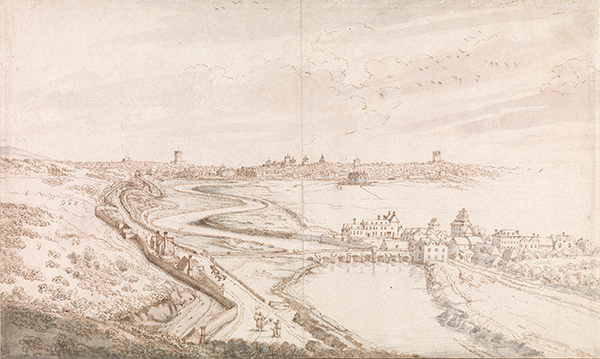FRANCIS PLACE IN IRELAND
Published in Issue 2 (March/April 2022), News, Volume 30By Helen Pierce
Each January, the National Gallery of Ireland (NGI) curates a month-long, free-of-charge exhibition based around items from the Vaughan bequest of watercolours by J.M.W. Turner. Drawings by the English artist Francis Place (1647–1728) were included in this year’s display, entitled ‘Turner & Place: Landscapes in Light and Detail’. The NGI owns a series of topographical sketches by Place, which were made during his travels in Ireland between 1698 and 1699.
Francis Place was an early ‘tourist’, coming to Ireland from his home in York for reasons of personal interest and curiosity rather than purposes connected to trade, religion or military surveying. Contemporary English visitors included Thomas Denton and James Verdon, who kept written records of their journeys in 1687–8 and 1699 respectively, but Place was one of the very first travellers to record his experiences primarily through images rather than words, and his drawings provide an important record of Irish urban and rural environments which went on to change significantly, sometimes entirely, over the next 300 years.
Place was born into a gentry family in the north of England and was sent to London in his late teens to pursue a career in law. The Great Plague of 1665, and a dislike of legal studies, saw him soon return home. He now had artistic aspirations: in London he had befriended the prolific Czech printmaker Wenceslaus Hollar, who introduced him to the practice of etching. In London, Place also acquired knowledge of an emerging printmaking technique, mezzotint, in which an image is constructed through tone rather than line. One of his earliest exercises in mezzotint, a copy of a Dutch tavern scene originally painted by Adriaen Brouwer, was published between 1666 and 1668. By the mid-1670s Place had settled in York, where he became part of a self-titled group of ‘Virtuosi’, with interests in natural philosophy, antiquarianism and the empirical study of the ways in which the world worked. This observational approach is consistently reflected in the detailed drawings in pen and ink or chalk, with water-based washes of colour often added, which Place frequently produced. Many of these drawings relate to his interest in travel, and record journeys made to the south coast of England, Wales, Scotland and Ireland, as well as landscapes and townscapes much closer to home.
Between 1698 and 1699 Place was in Ireland; the visual evidence of his drawings suggests a tour beginning in Drogheda, which proceeded south to Dublin and then to Kilkenny, concluding in Waterford before he sailed to Holyhead in north Wales. His motivations for visiting Ireland appear to have included family connections, intellectual interest and possible plans, ultimately not realised, to publish a series of etchings of Irish landscapes informed by his drawings.
Dublin from Phoenix Park is one of several views taken by Place from the (then) outskirts of the city. Islandbridge dominates the foreground of the image, with Place carefully recording the eight arches of the bridge installed over the Liffey in 1577 at the command of Sir Henry Sidney. To the left of the river, a wall encloses the edge of Phoenix Park, then a royal hunting-ground, while church towers dot the urban horizon. The drawing appears unfinished; in the mid-ground Place has included the infirmary of the newly constructed Royal Hospital at Kilmainham, but the much larger hospital building itself, which he carefully documented in four further sketches, is absent. Place’s viewpoint in this drawing comes from St Thomas’s Hill and the site of Phoenix Lodge, a house built by Sir Edward Fisher in 1611, which was demolished and replaced by the Magazine Fort in 1734. Place used pen and ink, adding watercolour washes for emphasis, with subtle tones employed in the immediate foreground of the hill and its vegetation, and on the roofs of the buildings at the edge of the park.
Following his death in 1728, the contents of what Place referred to as his ‘painting room’ in York, including multiple sketch-books full of drawings, were passed down through generations of his immediate family; the sketch-books appear to have been quickly disassembled into individual sheets. In 1931 most of this collection was auctioned at Sotheby’s in London, and the antiquarian John Maher acquired Lot 135, described in the sales catalogue as ‘Various views in Ireland’, and Lot 139, ‘Different views in or near Dublin … a particularly interesting series’. The bulk of Maher’s purchases were bought by the NGI in 1972 with the assistance of the Shaw Fund.
‘Turner & Place: Landscapes in Light and Detail’ at the NGI marked 50 years since these important drawings entered the national collection, offering visitors to both the on-site and virtual versions of the exhibition transformed views of familiar environments, as seen through the eyes of a late seventeenth-century adventurer.
Helen Pierce is a lecturer in Art History at the University of Aberdeen.

















